NRAO eNews
Volume Vol#, Issue Iss#
Day# Month# Year#
NRAO eNews
Volume Vol#, Issue Iss# • Day# Month# Year#

Upcoming Events

The ALMA2030 Vision: Design Considerations for the Next ALMA Correlator
Feb 11 - 13, 2020 | Charlottesville, VA

Detecting Extraterrestrial Technologies and Life
Feb 15, 2020 | Seattle, WA

35th New Mexico Symposium
Feb 21, 2020 | Socorro, NM

Jansky Lecture: Dr. Anneila Sargent
Feb 21, 2020 | Socorro, NM
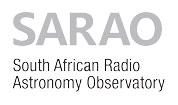
IUCAF 5th School on Spectrum Management for Radio Astronomy
Mar 2 - 6, 2020 | Stellenbosch, South Africa

From Collapsing Cores to Forming Disks
Mar 10 - 13, 2020 | Charlottesville, VA

The ALMA 2030 Vision: Design considerations for Digitizers, Backend and Data Transmission System
Mar 11 - 13, 2020 | Mitaka, Japan

From Cells to Galaxies 2020: Exploring the Synergies between Radio Astronomy and Medical Imaging
May 5 - 7, 2020 | Santa Fe, NM

17th Synthesis Imaging Workshop
May 13 - 20, 2020 | Socorro, NM

Multiphase Gas in Galaxy Groups
Jun 23 - 25, 2020 | Charlottesville, VA

Compact Objects and Energetic Phenomena in the Multi-Messenger Era
Jul 14 - 16, 2020 | Saint Paul, MN
NRAO Call for Proposals: Semester 2020B

The National Radio Astronomy Observatory (NRAO) invites scientists to participate in the Semester 2020B Call for Proposals for the Karl G. Jansky Very Large Array (VLA) and the Very Long Baseline Array (VLBA), High Sensitivity Array (HSA), and Global 3mm VLBI Array (GMVA).
The submission deadline for Semester 2020B proposals is Monday, 3 February 2020, at 17:00 EST (22:00 UTC).
Proposal preparation and submission are handled via the NRAO Proposal Submission Tool (PST) available at NRAO Interactive Services. Proposers who need assistance with proposal preparation or have questions regarding the Call for Proposals or NRAO telescope capabilities should contact Observatory staff via the NRAO Helpdesk. Note that using these tools (both the PST and the Helpdesk) requires registration.
ngVLA Project News
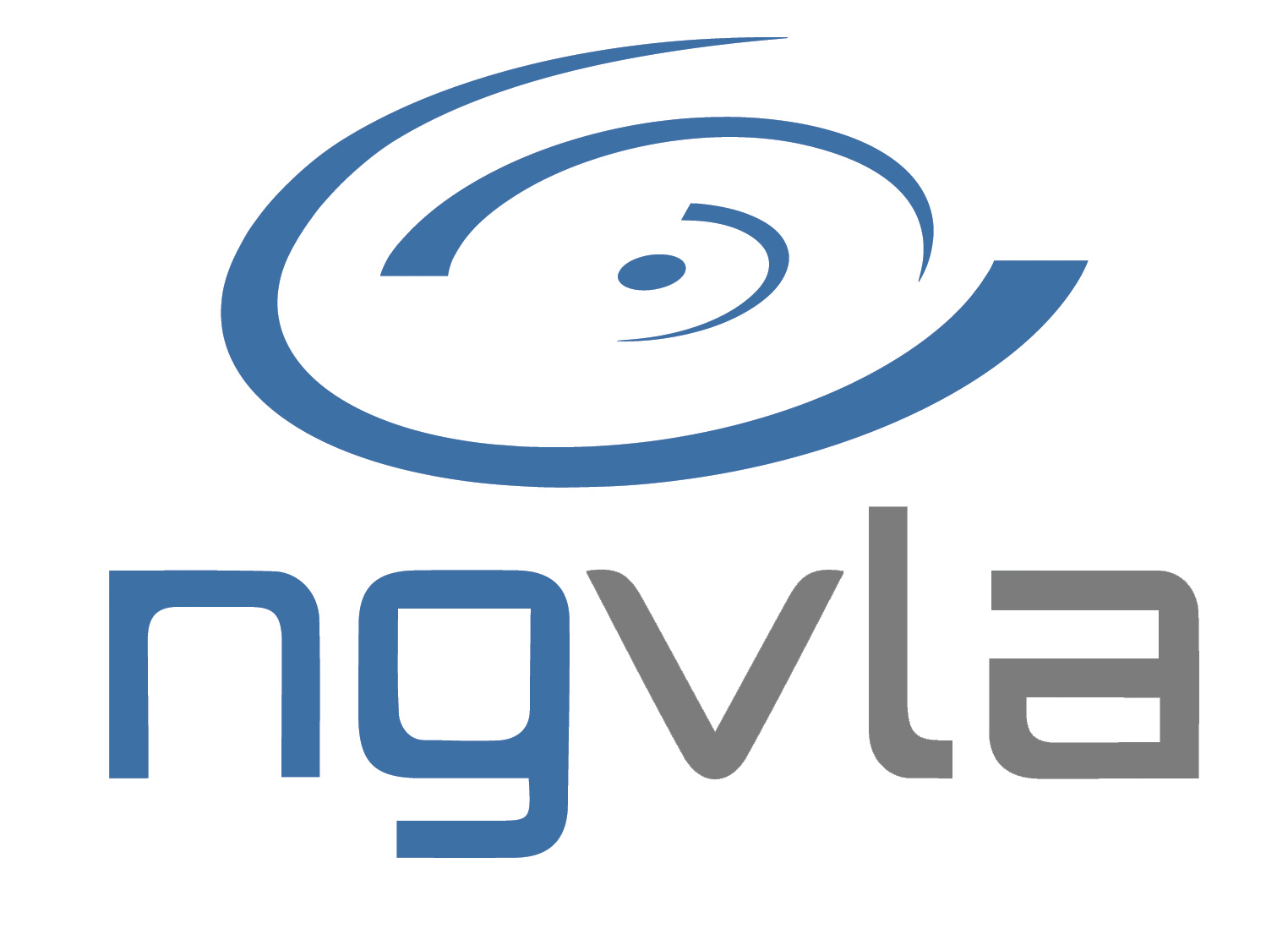
Astro2020 Presentation
On 3 February, from 1:30 - 4:45 pm PST, the next generation Very Large Array (ngVLA) Project will make a presentation to the Astro2020 Panel on Radio, Millimeter and Submillimeter Observations from the Ground. This presentation will occur during a session open to the public. We encourage ngVLA enthusiasts to attend this presentation either in person or online. Access information and an agenda are online.
ngVLA Project at AAS – Honolulu
The ngVLA Project says "Mahalo!" to the 31 presenters who made January's Special Session on The Scientific Quest for High Angular Resolution a tremendous success. The scientific content of the oral and poster sessions was outstanding, and led to both sessions being extremely well attended. The 31 presentations are available online.
Compact Objects and Energetic Phenomena in the Multi-Messenger Era
On 14-16 July, the NRAO and the ngVLA Project will convene a science conference titled Compact Objects and Energetic Phenomena in the Multi-Messenger Era in Saint Paul, MN, USA. Registration and abstract submission are open. Dr. Anne Kinney, head of the National Science Foundation’s Directorate for Mathematical and Physical Sciences, will give a keynote talk to open the conference. Kinney is responsible for determining how the Directorate pursues NSF’s 10 Big Ideas for future investment. One of the Big Ideas, Windows on the Universe, is focused on maturing the nascent field of multi-messenger astrophysics.
A conference report has been commissioned by Nature Astronomy.
ALMA Program News
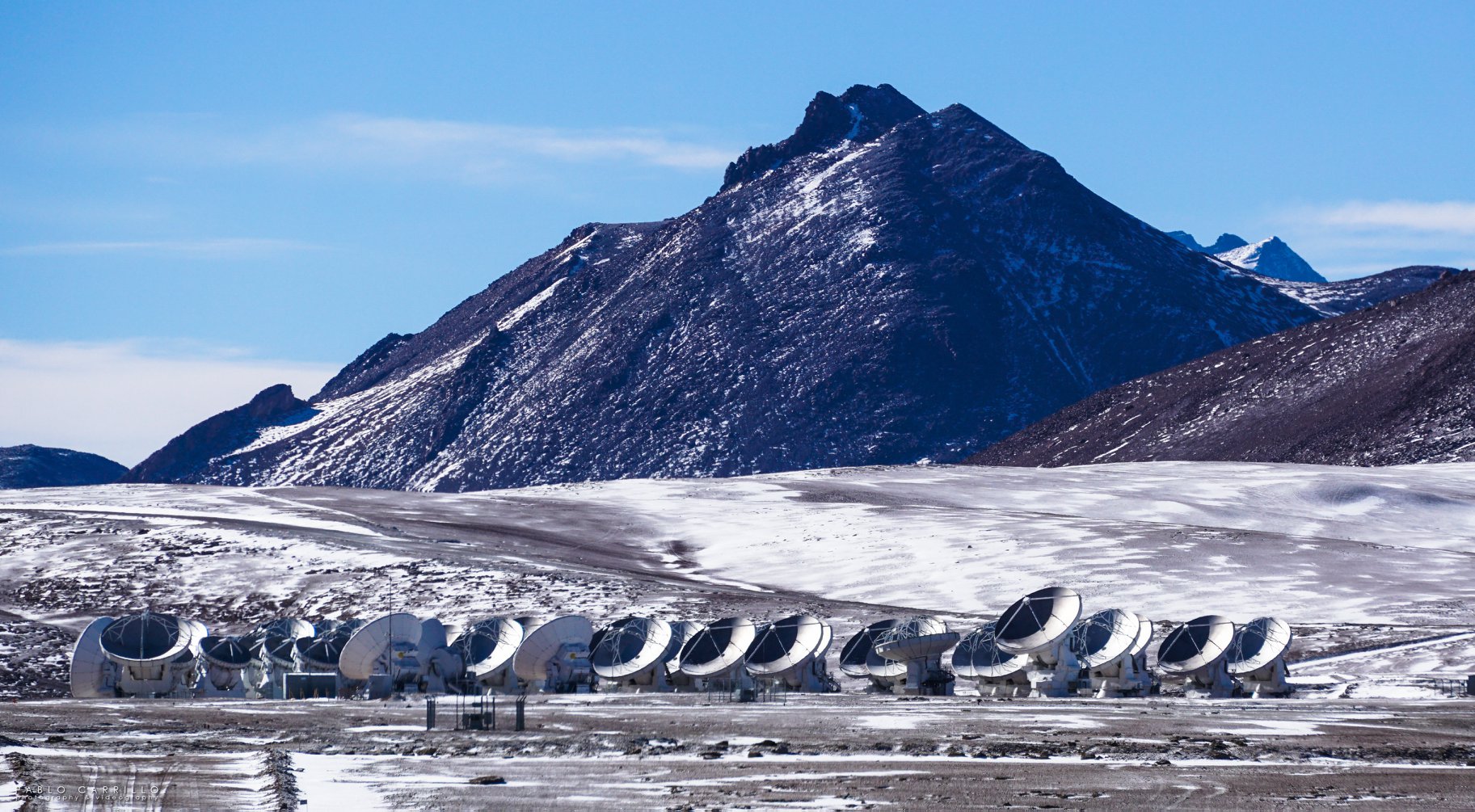
Pablo Carrillo
Although it is mid-summer at ALMA, in this season the westerly winds fail and moisture from the Amazon climbs the eastern face of the high Andes, falling as snow on the ALMA site. Operations are suspended for maintenance in February during this period of poor weather.
[click to enlarge]
Cycle 7 Observing
The current configuration is approximately C43-3 (0.5 km maximum baseline, 100 GHz beam 1.4 arcsec). ALMA is following a normal operations schedule. As usual, observations will be suspended for a maintenance period during February before resuming in March in C43-4 configuration in a series of expanding configurations. The first Band 1 (35-50 GHz) receiver from our partners in East Asia, is scheduled for installation during maintenance.
The Cycle 7 Atacama Compact Array (ACA) Supplemental Call for Proposals Deadline was 1 October 2019; a total of 249 proposals were received; 8199 hours were requested on the ACA; and 99 proposals requesting 3069 hours were successful. These proposals were reviewed using a distributed peer review system. Each team selected designated reviewers, resulting in 2490 assignments being made among 225 unique reviewers. Each of these reviewers received 30 or less proposals to review. Principal Investigator (PI) notifications have been issued. Successful proposals have entered the observing queue, and some projects have been delivered to the PI.
ALMA2030: ALMA Development
A Call for Proposals for ALMA Development Studies was released December 2019. The deadline for proposals is 1 May 2020 for funding during Fiscal Year 2021 — 1 October 2020 through 30 September 2021 — depending on the U.S. Federal budget process. We welcome any member from within the North America ALMA Operations Partnership to submit a proposal to investigate a potential ALMA upgrade aligned with the ALMA2030 goals. Several meetings designed to stimulate community discussion will be held in the next few months.
The ALMA2030 Vision: Design Considerations for the Next ALMA Correlator
The ALMA Development Roadmap has identified the multiplication of the IF bandwidth of ALMA (at least by a factor 2) as one of the main priorities for ALMA upgrades in the 2020s. This increase of the instantaneous bandwidth will be realized with the coordinated upgrade of the correlators the electronics feeding them: digitizers, backend and Data Transmission System (DTS) and the receivers ultimately supplying the signals. A series of meeting will be held this year to discuss considerations for all three elements needed do increase ALMA's bandwidth.
The first of these, a meeting to discuss considerations for the design of the next ALMA correlator, will be held in Charlottesville, Virginia, 11 - 13 February 2020. The final program was announced 6 January 2020. This meeting will bring together experts on the ALMA system and modern digital correlator design to: (a) discuss design requirements for the next generation ALMA correlator that enables the ALMA2030 vision; (b) share pros and cons of recent and currently under design correlator architectures; and (c) identify challenges for implementing and deploying a new ALMA correlator. Ultimately, this meeting will encourage and inform the submission of viable designs for the next ALMA correlator in the near future. Registration is now closed; visit the conference website for confirmed speakers and further information.
The second meeting in this series – The ALMA 2030 Vision: Design considerations for Digitizers, Backend and Data Transmission System – will be held 11 – 13 March 2020, at the National Astronomical Observatory of Japan in Mitaka. Registration is now closed; visit the conference website for confirmed speakers and further information.
The final meeting in this series of three that will discuss the ALMA front ends, including receivers, will be held in fall 2020 in Europe. Dates and details will be announced soon.
Science Meetings AAS
NRAO convened a Special Session – Breakthrough Science with the Atacama Large Millimeter/submillimeter Array – at the January 2020 American Astronomical Society (AAS) meeting in Honolulu, Hawaii. This session featured results from ALMA Large Programs and other related science.
Two science workshops sponsored by the North American ALMA Science Center convened in January. On 9 January, five dozen astronomers gathered to discuss Extreme Galactic Nuclear Activity: Ultraluminous Starbursts and AGN, A Symposium in Honor of Dave Sanders in Honolulu. Challenging the Perceptions of the Requirements for Life on Earth and Other Worlds was a Gordon Research Seminar on Origins of Life held 19 – 24 January 2020 in Galveston, Texas.
ALMA Ambassadors
The North American ALMA Science Center (NAASC) is excited to announce the 2020 ALMA Ambassadors. The Ambassadors program is at the core of the NAASC efforts to reach out to potential proposal Principal Investigators, and we are grateful for their contribution to the community. We are looking forward to meeting with the Ambassadors on 11 - 13 February at the National Radio Astronomy Observatory (NRAO) headquarters in Charlottesville, Virginia, and to working with them in the preparation of events at several institutions. Training will include topics related to ALMA proposal writing, including interferometry basics, ALMA science capabilities, recent ALMA headlines, use of the Observing Tool, and guidance with speaking on these topics. The postdocs will then host a proposal preparation workshop at their home and visiting institutions – similar to an abbreviated version of Community Day andNRAO Live! events from previous observing cycles – in advance of the Cycle 8 ALMA proposal deadline in April 2020.
| 2020 ALMA Ambassadors | ||
|---|---|---|
| Ambassador | Affilitation | Events locations |
| Veronica Allen | NASA Goddard Space Flight Center | NASA Goddard Space Flight Center and University of Maryland |
| Toby Brown | McMaster University | University of Toronto and Ohio State University |
| Christopher Faesi | University of Massachusetts - Amherst | University of Massachusetts - Amherst |
| Jorge Gonzalez Lopez | Carnegie Observatories & Universidad Diego Portales | Universidad de La Serena (Chile) and Universidad Diego Portales (Chile) |
| Danielle Lucero | Virginia Tech | University of Washington |
| Serena Perrotta | University of California, San Diego | Carnegie Observatories, Pasadena |
| Thomas Rice | Columbia University | Columbia University |
| Amy Sardone | The Ohio State University | Ohio State University |
| David Stark | Haverford College | Haverford College |
| Alexander Thelen | NASA Goddard Space Flight Center | NASA Goddard Space Flight Center and John Hopkins University |
| Ben Tofflemire | University of Texas, Austin | TBA |
| Andrey Vayner | John Hopkins University | John Hopkins University |
| Greg Walth | Carnegie Observatories, Pasadena | Carnegie Observatories, Pasadena |
NRAO and the NAASC Host an ALMA Special Session at the Honolulu AAS
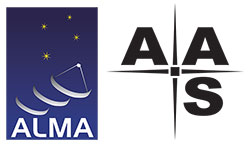
At the AAS Meeting in Honolulu, HI, a Special Session on Monday, 6 January highlighted several of the recent, exciting results from ALMA, including presentations on Large Programs and a talk on ALMA's anchoring role in the imaging of the M87 black hole by the Event Horizon Telescope. The well-attended session, titled Breakthrough Science with the Atacama Large Millimeter/Submillimeter Array, began with an observatory status report by ALMA Director Sean Dougherty. Dougherty highlighted ALMA's current operational status in Cycle 7 and pointed to planning for Cycle 8, for which proposals will be accepted in April 2020.
The status update was followed by a series of presentations on science results, starting with Sean Andrews (CfA) on the Disk Substructures at High Angular Resolution Project (DSHARP). Andrews presented a gallery of protoplanetary disks imaged by ALMA and described the ubiquitous rings and gaps, and (more rare) spiral and other substructures imaged in some of these disks. Ilse Cleeves (UVa) followed with a discussion of the detailed chemical structure and molecular variance observed in such disks. Eva Schinnerer (MPIA) then described the PHANGS project – Physics at High Angular resolution in Nearby GalaxieS – showing spectacular imaging of CO on the scale of giant molecular clouds in nearby, star-forming galaxies. Fabian Walter (MPIA) then described the deepest continuum image yet made for an extragalactic field, a product from the ALMA Spectroscopic Survey (ASPECS) in the Hubble Deep Field. Combined with spectral line data, the project provides a census of dust and molecular gas in the volume defined by the Ultra-Deep Field. Finally, Dan Marrone (Arizona) discussed ALMA's central role with the Event Horizon Telescope, showing the groundbreaking imaging of the supermassive black hole in M87, and discussing how these observations are used to estimate the mass of the black hole and to provide a test of General Relativity.
ALMA Top 10 Countdown
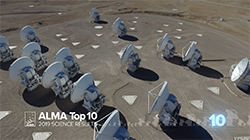
The first image of a black hole, the cold “glow” of the atmosphere and rings around Uranus, the sharpest view of young stars and planetary systems - these are just a few of the incredible discoveries that ALMA made possible in 2019.
Together with our favorite “Bad Astronomer”, Phil Plait, NRAO’s Education and Public Outreach office created 10 short videos to highlight ALMA’s most special observations.
You can find all 10 videos in our gallery here.
And read Phil Plait’s special countdown blog on SyFy here.
If you discover something newsworthy with ALMA, or another NRAO telescope, please contact our Public Information Officers, and maybe your discovery will be highlighted in next year’s countdown!
- For ALMA & NRAO: Iris Nijman, Charlottesville – inijman@nrao.edu | +1-434-296-0314
- For VLA & VLBA: Dave Finley, Socorro – dfinley@nrao.edu | +1-575-835-7302
Arizona Radio Observatory Call for Proposals

The Arizona Radio Observatory (ARO) solicits observing proposals for the ALMA Prototype 12-meter Telescope (12m) located on Kitt Peak, Arizona, and for the 10-meter Submillimeter Telescope (SMT) located on Mount Graham, Arizona, for the period March 1, 2020 – June 15, 2020. Proposal candidates should submit up to three pages of scientific and technical justification (including figures, tables, and references) in addition to their Proposal Summary Sheet.
All proposal candidates are required to list on the Proposal Summary Sheet their requested observing blocks (the exact LST ranges to be scheduled and number of times to be repeated), dates on which they are not available to observe, and dates in which sources in those observing blocks are within the Sun-avoidance zone (45 degrees at the SMT, 10 degrees at the 12m).
The 12m ALMA Prototype antenna currently supports dual-polarization sideband-separating (SBS) observations in three bands: 4mm (66 – 90 GHz), 3mm (84 – 116 GHz), and 1mm (211 – 275 GHz). Observations at 1mm must be clearly justified as to why they cannot be performed on the SMT. The 12m control system supports dual-polarization in the same sideband or single-polarization in each sideband (“2 IF mode”; fixed 6.0 GHz IF frequency), position-switched, beam-switched, and OTF observations. Backend modes for the AROWS spectrometer may be found on the ARO Equipment Summary and Status sheet.
The 10m SMT currently supports dual-polarization sideband-separating (SBS) observations at 1mm (211 – 280 GHz) and dual-polarization double sideband observations at 0.8mm (325 – 370 GHz). The SMT is the preferred site for 1mm observations. We note that 0.8mm weather is limited during this semester. The SMT control system supports both dual-polarization ("2 IF mode") and dual-polarization + dual-sideband observations ("4 IF mode") with tunable IF from 4.5-7.5 GHz, for position-switched, beam-switched, and OTF observations. Proposal candidates should consult the ARO Equipment Summary and Status sheet for additional technical specifications.
Remote observing is available. Observers who plan to observe remotely must supply fixed IP address(es) of the computer(s) that will be used during observing on their Proposal Summary Sheet. For further information about remote observing and other operational questions, please contact the ARO Software Engineers: Tom Folkers or Natalie Gandilo
Proposals will be reviewed by the ARO TAC and scheduling of successful proposals will be done according to availability of the receivers requested. The telescopes are expected to be available to the general astronomical community for a minimum of 10 percent of the scheduled time. Graduate student participation is especially encouraged. Institutions (or individuals) that wish to acquire longer commitments of time should contact Buell Jannuzi, Director: buelljannuzi@email.arizona.edu Next deadline for proposals is 23:59 MST on January 30, 2020. Proposals should be emailed in PDF format to: astro-aroproposals@list.arizona.edu
SMA Call for Standard Observing Proposals – 2020A Semester

We wish to draw your attention to the latest Call for Standard Observing Proposals for observations with the Submillimeter Array (SMA). This call is for the 2020A semester with observing period 16 May 2020 – 15 Nov 2020.
Standard Observing Proposals
Submission deadline: 05 Mar 2020 21:00 UTC = 05 Mar 2020 16:00 EST = 06 Mar 2020 05:00 Taiwan
Proposal Information and Submission
The SMA is a reconfigurable interferometric array of eight 6-m antennas on Maunakea jointly built and operated by the Smithsonian Astrophysical Observatory and the Academia Sinica Institute of Astronomy and Astrophysics. The array operates in the 230, 345 and 400 GHz bands, observing simultaneously with two orthogonally polarized receivers, one in the 230 GHz or 345 GHz band and the other in the 240 GHz or 400 GHz band (with full polarimetric observations available using the 230+240 or 345+400 band combinations).
The SMA configurations include antenna separations ranging between 9 m and 508 m. The small antennas allow access to low spatial frequencies (with projected baselines as short as 6-m) in the sub-compact configuration, and at the other extreme, the finest angular resolution with the very extended configuration at 345 GHz is ~ 0.25". The compact and extended configurations complete the range. The characteristics, performance and sky coverage of the SMA are both similar and complementary to those of the stand-alone Atacama Compact Array (ACA) component of ALMA, while providing full access to the northern sky.
The heart of the SMA backend is the SWARM correlator, able to process 8 GHz bandwidth (IF coverage of 4 to 12 GHz) for each receiver in each sideband, for a total of 32 GHz bandwidth, at a uniform 140 kHz resolution. We are currently expanding the correlator coverage by 50%, to 12 GHz bandwidth (IF coverage from 4 to 16 GHz) for each receiver in each sideband, for 48 GHz total bandwidth, while maintaining the fine 140 kHz uniform resolution. While not yet fully commissioned, we are working toward offering this new capability in 2020A as a shared-risk opportunity.
The SMA can tune the orthogonal receiver combinations independently, resulting in a very flexible frequency coverage capability. For example, observations can be made at 1.3 mm and 870 micron simultaneously (with many other configurations possible). One popular configuration allows the current 8 GHz/sideband/receiver frequency coverage to cover up to 32 GHz contiguously, where the tuning ranges overlap for the two orthogonally polarized receivers. Alternatively, the two receivers can be set with the same LO to cover the same 16 GHz (8 GHz in each sideband) of frequency space in the two orthogonally polarizations, allowing improved spectral line sensitivity. In such a case, full Stokes polarization measurements are also possible at 1.3 mm and 870 microns. When our upgrade is completed to 12 GHz/sideband/receiver, the frequency coverage will be configurable to cover 44 GHz contiguously (with 4 GHz of overlap), or can be configured to cover the same 24 GHz (12 GHz in each sideband) with the same LO.
The SMA provides flexible, wide band frequency coverage that delivers high continuum sensitivity and excellent spectral line capabilities. A full transit observation with the current 8 GHz/sideband/receiver correlator coverage will offer continuum sensitivity of 250 or 600 micro-Jy (1 sigma) at 230 or 345 GHz in good weather conditions (precipitable water vapor 2.5 mm and 1.0 mm, respectively). When the correlator upgrade is fully commissioned this will improve the continuum sensitivities by 22% per unit time. The corresponding line sensitivities at 1 km/s resolution are 35 and 80 mJy.
For more information about SMA capabilities, visit the SMA Observer Center website and explore the set of SMA proposing tools. Current and archived SMA Newsletters provide a sampling of the wide variety of science possible with the SMA.
For more details visit the SMA Observer Center Proposal Information Page.
IMPORTANT DATES FOR STANDARD OBSERVING PROPOSALS
- Submissions open: 06 February 2020 (on or before)
- Submissions close: 05 Mar 2020 21:00 UTC = 05 Mar 2020 16:00 EST = 06 Mar 2020 05:00 Taiwan
Due to current and expected investment in further upgrades to the SMA capabilities, as well as obligations to previous approved programs, the Large Scale Projects program (for projects requesting 100 to 1000 hours) will not be accepting proposals at this time.
Questions or comments regarding the Standard Observing Proposals can be addressed to sma-proposal@cfa.harvard.edu.
Interferometry and Synthesis in Radio Astronomy
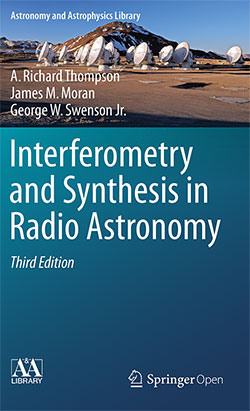
The third edition of the textbook Interferometry and Synthesis in Radio Astronomy by Dick Thompson, Jim Moran, and George Swenson was published by Springer International.
This book has been a popular reference on radio interferometry since the first edition appeared in 1986. The new edition is 25% longer than the second edition of 2001, has been extensively revised, and contains much new material. Advanced data restoration techniques such as compressive sensing are described; and the section on visibility model fitting has been greatly expanded. The discussion of atmospheric propagation and site characterization has been thoroughly updated. Modern spectral analysis techniques such as polyphase filter banks are explained, and a generalized treatment of correlation of quantized signal is included. Tutorial appendices have been added on the radiometer equation, basic Fourier transform theory, the discrete Fourier transform, and the derivation of the structure function for two- and three-dimensional turbulence.
This book is available as an Open Access publication. It is published under the Creative Commons Attribution License and can be downloaded by anyone free of charge at www.link.springer.com, and hardbound copies are available for $60 from Springer, Amazon.com, and other bookstores. Softbound “my copy” versions are available for $25 at institutions that have Springer subscriptions. Open Access availability was made possible by publication grants from Harvard University and the National Radio Astronomy Observatory.
IUCAF 5th School on Spectrum Management for Radio Astronomy
The 5th IUCAF School on Spectrum Management will take place 2 – 6 March 2020, and will be hosted by the South African Radio Astronomy Observatory (SARAO) in Stellenbosch, South Africa.
This School offers a comprehensive view of the technical and regulatory issues related to radio astronomers' use of the spectrum. Spectrum management is a task of rapidly growing importance for radio astronomy as well as for other radio services; however, it is not part of any academic curriculum; radio astronomers have to learn it by doing it. The IUCAF School in Spectrum Management will be an opportunity to profit from the experience of colleagues.
The expected audience would be members of the radio astronomy and related radio engineering community, who are becoming active in this area at the local, national, or international level, and regulators whose task is to protect passive services and science services. These skills have critical application to science, commerce, and government.
IUCAF spectrum management schools were previously held in 2002 (Green Bank, West Virginia, USA), 2005 (Castel San Pietro Terme, Italy), 2010 (Mitaka, Japan) and 2014 (Santiago, Chile) and were important milestones in radio astronomy's efforts to preserve access to the radio spectrum.
Additional information regarding this School is available online.
From Cells to Galaxies 2020: Exploring the Synergies between Radio Astronomy and Medical Imaging
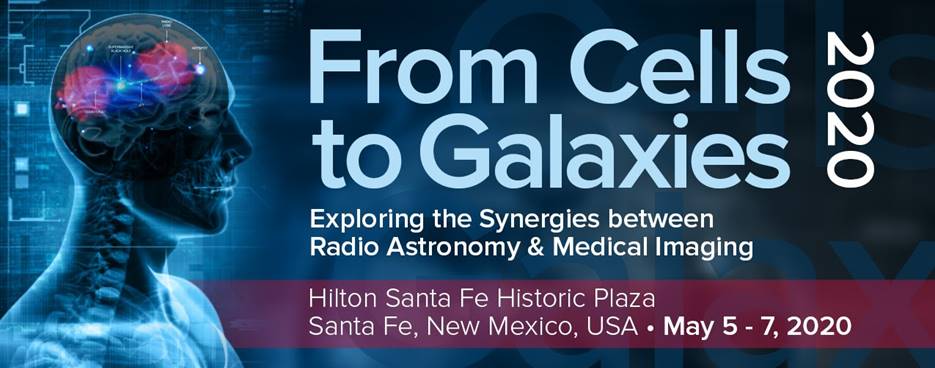
The “From Cells to Galaxies 2020” meeting will be held in Santa Fe, New Mexico May 5-7, 2020. Through this meeting we seek to bring together researchers from the fields of Radio Astronomy Imaging and Radiological Imaging to share ideas and stimulate discussions about joint research that can benefit both communities through collaborative development projects.
Building on the inaugural planning meeting that was held in April 2019, the specific goal of the 2020 “From Cells to Galaxies” meeting is to host an “active” workshop. The agenda includes hands-on data analysis and cross-disciplinary applications of imaging techniques. We invite all interested Radio Astronomy and Medical Imaging professionals interested in these synergies to participate.
Recent Media Releases
|
Astronomers Find Wandering Massive Black Holes in Dwarf Galaxies |
|
|
The Turbulent Life of Two Supermassive Black Holes Caught in a Galaxy Crash |
From the Archives
Ellen Bouton

[click to enlarge]
About this month's photo: What do you do when you want to tilt a telescope further? Dig a ditch, of course! The 300 Foot Telescope in Green Bank began operations in October 1962 after a mere 18 months of construction. But the antenna could not be moved over the full 60 degree range of zenith angle allowed by the drive system without the rim hitting the ground. Frank Drake suggested digging a ditch on the south side to lower the elevation limit. Excavations hit bedrock just six feet below the surface. Perhaps some dynamite? Many were anxious that a blast might damage the new antenna. Rocks and debris flew, one rock put a foot-wide hole in the telescope surface, but there was no other damage, and the southern declination limit was successfully extended to minus 19 degrees.
From the Archives is an ongoing series illustrating NRAO and U.S. radio astronomy history via images selected from our collections of individuals' and institutional papers. If readers have images they believe would be of interest to the Archives, please contact Ellen Bouton.

